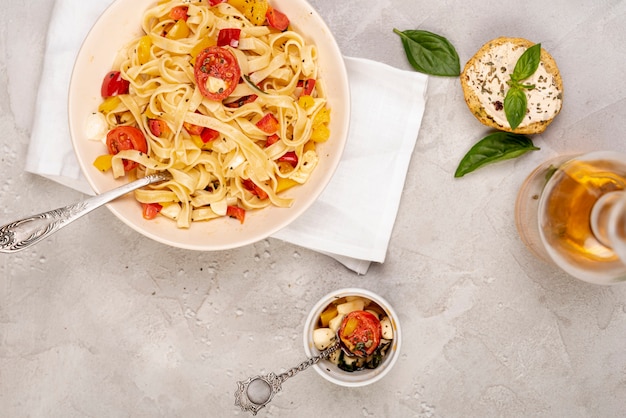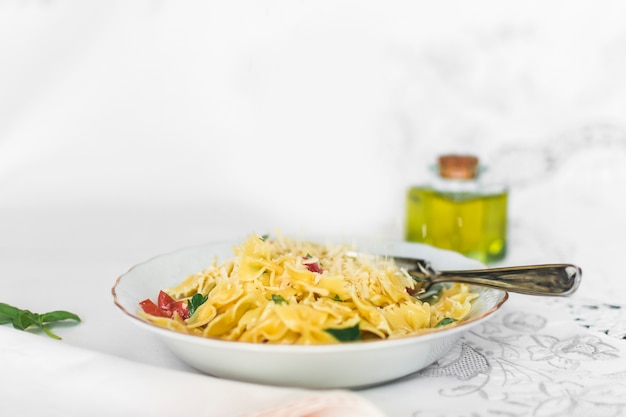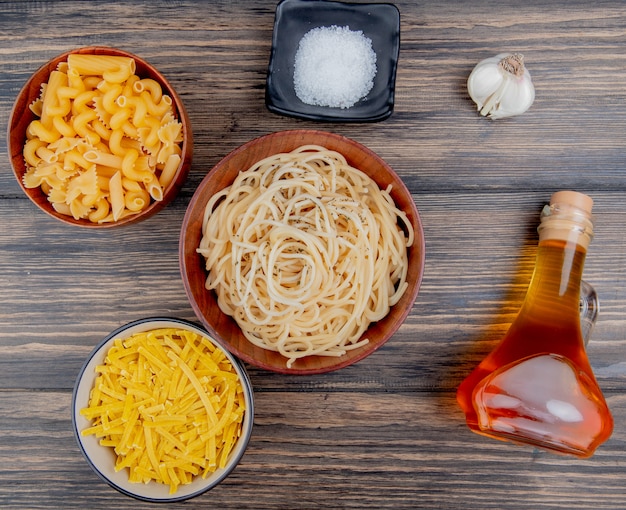Carbonara. Just the word evokes images of creamy, dreamy pasta coated in a luscious sauce, the perfect comfort food. But let me tell you, this seemingly simple dish has a few secrets, and it's easy to get it wrong. Believe me, I've been there, tasted the disappointment of a watery, bland sauce, and learned from my mistakes. So, let me guide you on the path to the ultimate carbonara, a dish that will have you swooning with every bite.
(Part 1) The Carbonara Creed: A Philosophy of Simplicity

Before we dive into the details, let's establish the foundation: the Carbonara Creed. This isn't a recipe for those who like to add a million ingredients; it's a celebration of simplicity, of a few perfectly chosen elements that sing together in perfect harmony. Forget the heavy cream, the garlic, the onions, the mushrooms. We're going back to basics, to the heart and soul of this iconic Italian dish.
The Cardinal Rules of Carbonara
Here's my carbonara mantra, the rules I live by:
- Guanciale is King: This cured pork cheek is the king of carbonara, bringing a smoky, salty depth of flavour that no other ingredient can match. Pancetta? It's just not the same. Don't settle for anything less.
- Eggs are the Soul: The heart of the carbonara lies in the eggs. Fresh, high-quality eggs are the secret to a truly creamy, rich sauce that melts in your mouth.
- Pecorino Romano is the Cheese of Choice: This sheep's milk cheese, sharp and salty, perfectly balances the richness of the dish. No Parmesan, no substitutions!
- pasta water: The Unsung Hero: This starchy liquid is your secret weapon. It's the key to emulsifying the sauce, creating that velvety texture that makes carbonara so special. Don't dare drain it all away!
(Part 2) The Guanciale: A Journey from Crisp to Creamy

Let's talk about the star of the show: guanciale. This cured pork cheek is where the flavour adventure begins. Now, you might be thinking, "Where on earth do I find guanciale?" Don't worry, it's not as rare as you think. Head to a well-stocked butcher or an Italian deli, and they should have it. It's worth the hunt, I promise you.
The Art of Cooking Guanciale
The key to perfect guanciale is to cook it low and slow over low heat. This allows the fat to render out slowly, creating a pool of golden liquid that will be the base of your sauce. Slice the guanciale thin and cook it until it's crispy and golden brown, but not burnt. You'll know it's ready when it practically melts in your mouth.
Saving the Fat for the Sauce: A Golden Treasure
Don't you dare throw away that golden guanciale fat! That's where the magic happens. This rendered fat is infused with all the smoky, salty flavour of the guanciale, and it's what gives the carbonara its signature richness.
(Part 3) The Pasta: A Foundation of Bite

Now, onto the pasta. Spaghetti is the classic choice, and for good reason. It holds the sauce perfectly, creating a delicious mouthful with every twirl.
Choosing the Right Pasta: Al Dente is the Key
Remember, the pasta needs to be al dente, with a slight bite. Overcooked pasta will turn into a mushy mess, and it will absorb the sauce too quickly, leaving you with a gloopy, disappointing result.
The Importance of Pasta Water: Starchy Magic
And here's a crucial point: don't drain all the pasta water! Reserve a cup or two of that starchy liquid. It's not just a waste product; it's the secret ingredient that helps to emulsify the sauce, creating a creamy, silky texture that coats the pasta perfectly.
(Part 4) The Eggs: A Symphony of Richness
Now, let's talk about the eggs. Freshness is key. I usually use a ratio of 2 large eggs per 100g of pasta. You can even add an extra yolk or two for an even richer flavour, but don't overdo it.
Whisking for Smoothness: A Perfect Emulsion
The eggs need to be whisked vigorously with a generous amount of freshly grated Pecorino Romano. We're aiming for a smooth, silky emulsion, the foundation of our creamy sauce.
Don't Overcook the Eggs: Gentle Heat
Remember, the eggs will cook in the heat of the pasta and guanciale fat. So, don't overcook them! Just a few seconds of gentle stirring will be enough to create that silky, luscious texture.
(Part 5) The Assembly: Bringing it All Together
We've got the guanciale cooked, the pasta perfectly al dente, and the eggs whisked to perfection. Now it's time to bring it all together.
Adding the Pasta to the Sauce: A Hot Embrace
Transfer the pasta directly from the pot to the pan with the guanciale fat. Add a couple of ladles of the pasta water to the pan, and stir it all together to create a smooth, creamy base.
Whisking in the Eggs: The Moment of Truth
This is the crucial step, the moment of truth. Slowly pour the egg mixture into the pan, whisking constantly. The heat from the pasta and the fat will cook the eggs, creating a velvety sauce that clings to the pasta.
The Finishing Touches: Salt, Pepper, and Love
Keep whisking until the sauce is creamy and glossy. Season with salt and black pepper to taste. Don't overcook it; just a few seconds is all you need.
(Part 6) The Perfect Plate: Presenting Your Creation
You've got your carbonara, your culinary masterpiece. Now, it's time to plate it with a touch of artistry.
The Plating Process: A Touch of Elegance
I prefer to serve it in shallow bowls, with a generous amount of pasta and sauce. A sprinkle of freshly grated Pecorino Romano on top adds the finishing touch.
The Art of Presentation: A Feast for the Eyes
Remember, food isn't just about taste; it's also about presentation. Take your time, arrange the pasta beautifully, and make it a feast for the eyes as well as the palate.
(Part 7) The Taste Test: The Moment of Truth
Finally, it's time for the moment of truth: the taste test. Take a forkful, and let it melt in your mouth. The creamy sauce, the salty guanciale, the sharp Pecorino Romano, all coming together in perfect harmony.
The Perfect Bite: A Symphony of Flavours
If it's done right, the carbonara will be a symphony of flavours, a celebration of simple ingredients cooked to perfection. It should be rich and satisfying, but not heavy. It should leave you wanting more.
The Experience: More Than Just a Meal
And remember, carbonara is not just a dish, it's an experience. Enjoy every bite, savour the flavours, and let the creamy goodness transport you to a world of pure culinary delight.
(Part 8) Variations and Twists: A Touch of Personal Expression
You've mastered the classic carbonara, but maybe you're looking for a little something extra, a little personal touch. Let's explore some variations!
Carbonara with a Touch of Spice: A Warm Embrace
For a bit of heat, try adding a pinch of red pepper flakes to the sauce. This will add a subtle kick that complements the richness of the dish, a warm embrace for your taste buds.
Carbonara with Mushrooms: A Savoury Depth
Another popular variation is to add sauteed mushrooms to the sauce. I like to use a mix of cremini and shiitake mushrooms, but feel free to experiment with your favourites. The mushrooms add a savoury depth to the dish, a harmonious blend of earthy and creamy.
Carbonara with Asparagus: A Springtime Delight
For a lighter, more springy touch, try adding roasted asparagus to the sauce. The asparagus adds a delicate sweetness that contrasts beautifully with the richness of the carbonara, a refreshing symphony of textures and flavours.
(Part 9) FAQs: Answers to Your Questions
Now, let's address some frequently asked questions about carbonara.
What happens if I use Parmesan cheese instead of Pecorino Romano?
I know, it's tempting to reach for the Parmesan, but trust me, Pecorino Romano is the key to the authentic carbonara flavour. It has a sharper, saltier flavour that balances the richness of the dish perfectly.
Can I use pancetta instead of guanciale?
It's not ideal, but if you can't find guanciale, pancetta is a decent substitute. However, it won't have the same smoky, salty flavour, so you'll need to adjust the seasoning accordingly.
How long does it take to make carbonara?
From start to finish, a carbonara can be whipped up in about 20 minutes. That's one of the things I love about it: it's a quick and easy meal that still feels special.
Is carbonara really that hard to make?
It might sound intimidating, but it's really not that hard. Just follow the steps, and don't be afraid to experiment!
What is the best way to store leftovers?
Carbonara is best served fresh, but if you do have leftovers, store them in an airtight container in the refrigerator for up to 2 days. Reheat gently in the microwave or on the stovetop.
(Part 10) Conclusion: A Journey of Taste
So there you have it, my take on the ultimate carbonara. It's a journey of flavour, a culinary adventure that's as simple as it is delicious. Remember, it's all about using high-quality ingredients and following the basic principles. Don't be afraid to experiment, to add your own personal touch, and to create a carbonara that's truly your own. Enjoy the journey, and happy cooking!
Everyone is watching

Corn on the Cob: The Ultimate Guide to Perfectly Cooked Ears
Healthy MealsAh, corn on the cob. Just the name evokes images of sunny days, barbecues, and that sweet, juicy flavour that ...

Perfect Pork Roast Oven Cooking Time: A Guide to Delicious Results
Healthy MealsThere's something truly satisfying about a perfectly roasted pork. The aroma alone is enough to make your mout...

Scallops: The Ultimate Guide to Perfect Cooking
Healthy MealsAh, scallops. Those delicate, sweet, and utterly delicious morsels of the sea. They hold a special place in my...

Ham Cooking Time: How Long to Bake, Smoke, or Boil a Delicious Ham
Healthy MealsAh, ham. It's a classic, isn't it? A real crowd-pleaser, especially around holidays. And when done right, it'...

Spaghetti Squash: The Ultimate Guide to Cooking and Serving
Healthy MealsRemember that time you saw spaghetti squash at the supermarket, looking all bumpy and strange, and thought, "W...
